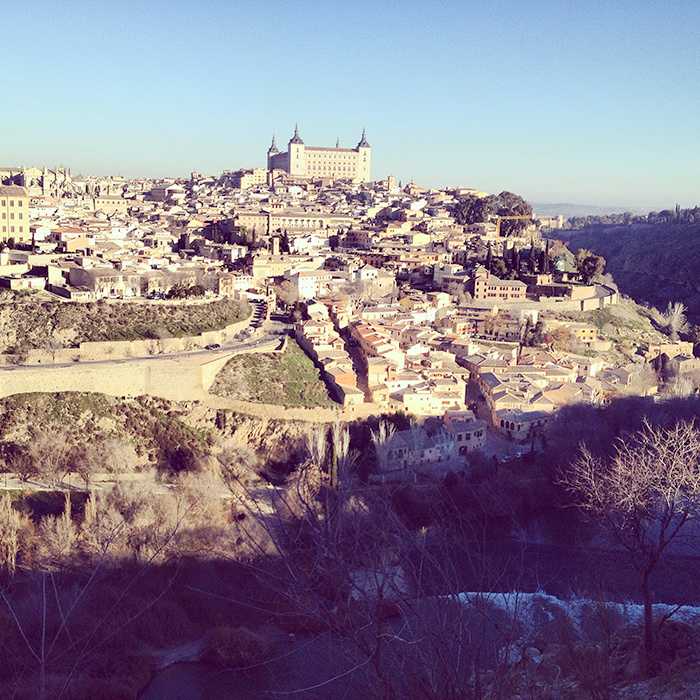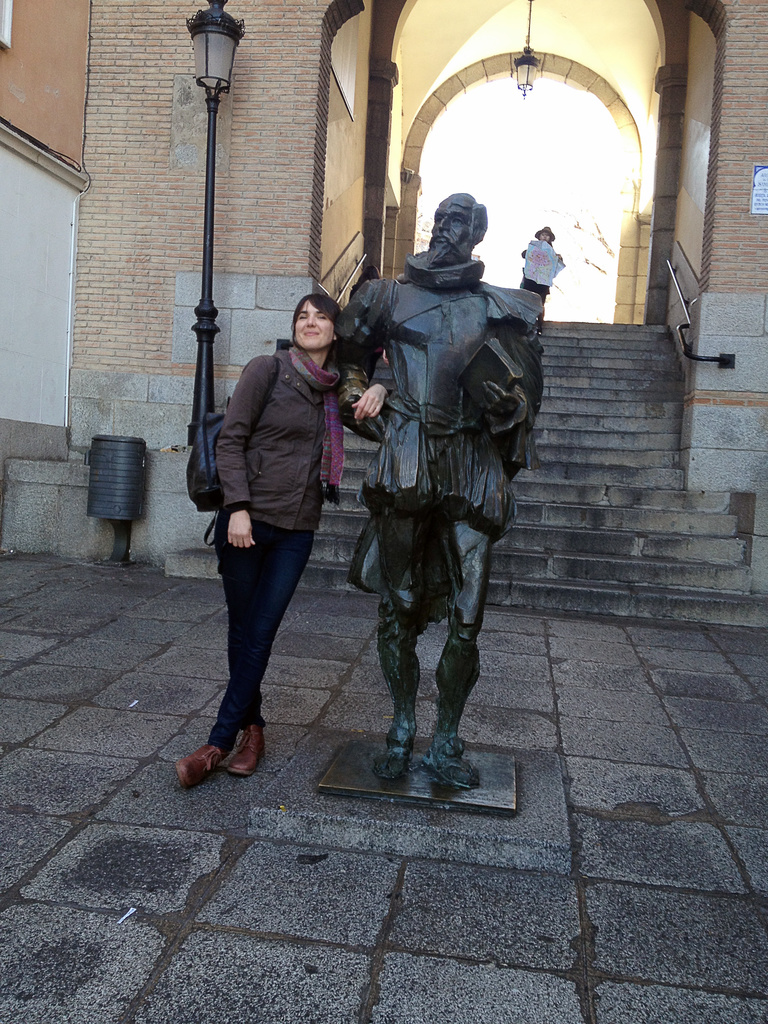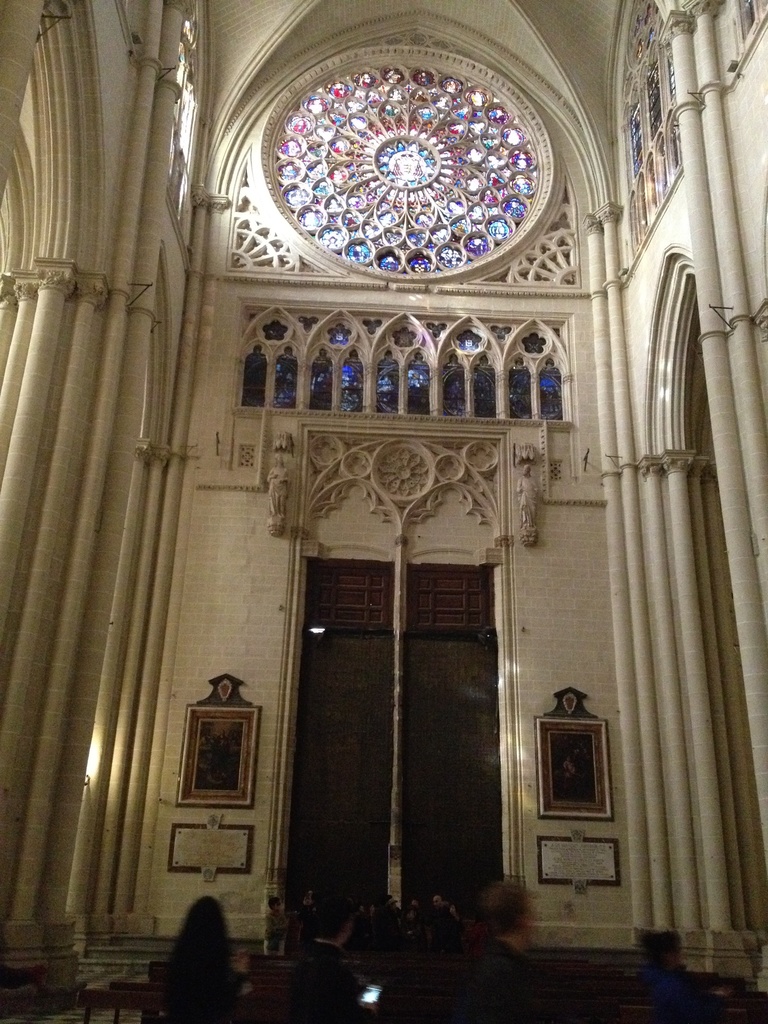By Heidi McKinley
“Why! who makes much of a miracle?
As to me, I know nothing else but miracles.”- Walt Whitman
On my third day in Spain, I learned about the expert pickpockets of Madrid. It wasn’t simply through Ibon’s sound advice to get a money belt or to sling packs in front of our bodies where we could see them. No, I had to learn the hard way.
I’m blaming it on the fact that I’m from a town where we don’t even lock our bikes. I implicitly trust everybody. However, belief rarely lines up with reality and in less than a week abroad I found myself wallet-free. Still, I’m optimistic that not every lesson that day was lost on me. Before I was so swiftly and silently robbed, I absorbed some stories about Spain’s long and complicated history, which, on more than one occasion, involved miracles.

"From our vantage point on an opposite hill, the entire vista fit perfectly in one snapshot."
It was one a.m. in Iowa when I woke up an hour past dawn in Spain. After a breakfast of croissants, cheese, and nearly an entire litre of coffee, I piled into a tour bus with the rest of the bleary-eyed students. Still suffering from jet lag, I nodded in and out of consciousness as our tour guide told us over the loudspeaker that we would be visiting the quintessential Spanish city of Toledo. When the bus finally stopped, I opened my eyes and saw the sheer-sided ancient metropolis rising from the banks of the Tagus River like a meticulously sculpted sandcastle. This was the ancient Visigoth capitol. Now, the city is the capital of the province of Toledo and an official UNESCO World Heritage Site. From our vantage point on an opposite hill, the entire vista fit perfectly in one snapshot.
Today Toledo stands as an ideal example of early Spain where narrow cobblestone streets wind between buildings designed by the Jewish, Christian, and Moorish people who co-existed here. The idea that these three societies could live alongside one another and even collaborate seemed phenomenal to me. We visited Santa Maria la Blanca – a Jewish synagogue named after a Christian saint. Inside the Star of David interlaced with the intricate, an-iconographic mosaics of the Moors. My mouth hung open in delighted disbelief as I scanned the walls for more disparate symbols. In light of the recent shootings in Paris, I was moved to think what it must have been like to live in a society of such tolerance.
As we trekked along, Ibon leaned toward me to say that in certain corners of these narrow streets, when no other tourists were around, it was easy to imagine that you were living in a time long past. And it was true. Even with our large and loud group, I could easily picture myself walking to the fuente for water, picking an orange off a tree in the huerto, or buying a jar of olives in the Zocodover market. We continued our walk as Rosario, our guide, pointed out many diverse places of worship, like the church of San Sebastián, and the Mosque of Cristo de la Luz.

Posing with a statue of Cervantes in Toledo

Stained glass windows in Toledo’s Gothic cathedral
“They were not afraid of God,” explained Rosario, as we craned our necks and spun in slow circles to take in the arched domes and the candied light of the stained glass windows, which bloomed out of the walls of Toledo’s Gothic cathedral like mystical flowers. The city seemed steeped in miracles.
Some say the Cathedral of Toledo is one of the greatest Gothic structures in Europe. Inside there were intricate golden alter pieces, opulent sculptures, tangled mahogany carvings, and angelic ceiling paintings by Luca Giordano. One high window, flanked with paintings of blue sky, pastel clouds, and billowy robed saints, was specially designed to direct beams of sunlight through a hole in the altarpiece, where it fell directly upon the tabernacle.
Cathedrals throughout Europe were made as a way for common, hardworking people to feel closer to God. I once saw a television show that said cathedrals “lifted medieval minds out of the dirt and darkness of daily life, creating an otherworldly experience.” The building made me feel as if I personally wasn’t trying hard enough (I suppose that was kind of the point.) The immensity of the project seemed impossible.
“How could anyone build such a thing?” Francesco asked.
“It was another time,” Rosario said as a matter of fact (and entire) answer. Another time…right. I snapped pictures of the windows which dimmed as if wilted on my camera screen.
Cathedrals appeared in Europe more than one thousand years ago. Was this one built during a time when God still spoke out loud, and when pillars of smoke led pilgrims through the desert? Or was it after he went silent, an attempt to draw him back?
Rosario explained how the site of construction was decided by another miracle. Ildefonso, Archbishop of Toledo in 657, was given a holy garment here by Mary herself.
“What kind of garment?” I asked.
“A golden cape,” said Rosario. Though the verdict is still out on whether it was a red cloak or a green blanket, I trusted Rosario’s version. I imagined Ildefonso covering the bottom half of his face like Batman and then opening his arms wide in an empty field to declare that this was the place they would build the cathedral. In fact, this was how the sites of many churches and cathedrals were decided –not by men in golden capes, but as the sites where someone experienced a miracle. One story concerning the cathedral at Santiago De Compestela in northwest Spain, says the cathedral was erected after a monk found the bones of St. James there. One story says that the bones, miraculously, were brought there by dolphins.
“Stranger things have happened,” he might’ve said, shrugging.
On the bus ride home I thought how the construction of such a building could probably be explained logically (just as the existence of creatures like dolphins could), but still the time and effort which went into its making staggered me. Did people have less to do then? Or did they just waste less time?
I got back to the hotel determined to make use of every minute. So, even after a long day of touring, when Michelle and Laura invited me to go with them to visit the Reina Sofía Museum I quickly agreed. We had a coffee in the hotel cafe and set out. The night air was cool and it was still early but the sun had already gone down. The city was well lit in the golden glow of street lamps. There were people everywhere on their way to dinner or to the plaza to enjoy their Saturday night. We asked a friendly group for directions and, though their English was bad and our Spanish worse, we worked out the proper directions.
When we passed a gutted handbag resting on a windowsill I reached behind me and patted my backpack, making sure the zipper was pulled to the bottom corner, feeling perfectly secure as we skirted the Fuente de la Alcachofa (which directly translates as the Source of the Artichoke or Artichoke Fountain.) Even so, after three more blocks a stranger tapped me on the shoulder and asked if I knew that my bag was open.
No, I did not know that.
The other two girls stood there in stunned silence as I rummaged through my bag to see if anything had gone missing. My wallet, which stupidly contained my passport, driver’s license, two credit cards, and 120 euros, had vanished. My heart dropped a half-step. But then I steeled myself to remaining calm in the face of whatever. A strange sense of fate and the knowledge that it could be worse had taken hold of me and been reinforced over the last few days while touring the fortresses where so much blood had been spilled and the shadows of the cathedrals where countless people had lived out demanding lives of labor and penance. I breathed a sigh of relief to be living, let alone in the present. I looked up at the other two girls.
“Maybe it fell out,” I said, knowing it hadn’t. “You two go on ahead. I’ll go back and check at the cafe.”
“Are you sure?” said Laura, genuinely concerned.
“I would totally be freaking out right now,” said Michelle. This statement shot a bolt of adrenaline through me and heated the skin around my eyes, but I took another breath.
“At least I wasn’t stabbed,” I said, honestly grateful. “And how amazing was that? I didn’t feel a thing.” I had been in the presence of a true wallet lifting virtuoso. I almost regretted not being able to witness such artful thievery.
I walked back to the hotel with my bag slung in front of me though the precaution did little good for me now. I checked the cafe, but of course it wasn’t there. Mostly I was embarrassed as I confessed to the front desk that I’d lost my passport.

Saying 'adios' to the streets of Madrid.
That night I canceled my credit cards online and then found out that to get a new passport I would have to go to Barcelona and jump through myriad hoops, many of which I couldn’t quite decipher from the website of the Spanish Consulate. I decided to leave it all until morning since the embassy was closed at this hour anyway. At breakfast I told Ibon my misfortune. His look of concern unnerved me and I overcompensated with mock chillness.
“I’m going to call and report it later today,” I said, shrugging. “Anyway, maybe it just fell out of my bag. I’ll keep looking.”
“Yes, it would be very difficult to get a new one,” he said. “Keep looking.”
I packed up my belongings and checked with the front desk again but there was nothing. My passport, visa, and only means of paying for anything (apart from the cash I’d luckily left in the room) were gone.
We boarded the buses again and began the long journey to Bilbao where we’d be staying for the rest of the semester. As we drove I tried to keep my mind on other things but couldn’t help going over and over all I’d done wrong. They’d told us countless times not to carry around our passports, and also to not carry backpacks without zipper locks. They’d said to use hidden methods for carrying cash and cards, and that thieves had many tricks including working in teams to distract while the other went to work, even riding on the back of a motorcycle and yanking purses from the hands of unwary tourists. They’d slash the bottoms out of bags, they’d “bump” into a person and apologize while extracting the wallet with a flick of their nimble wrists. I wasn’t sure how my particular heist had taken place but I tried to imagine it. Had it been the polite old woman in the shabby purple hat I’d stepped aside for at the crosswalk? Had the man in the tailored suit pulled one over on me as I admired his pointed leather shoes? I was in the middle of an especially colorful scenario where the pickpocket had trained a pigeon to swoop down and snatch the contents of my bag, when Ibon walked to the back of the bus and leaned over my seat.
“I have some good news,” he said. I looked up from my reverie with what I hoped was a look of poise and togetherness. “Someone returned your wallet.”
My eyes widened and my mouth dropped open, betraying me.
“Apparently they found the contents along with your room key and brought it to the hotel.”
“Really?” I said. I was as shocked by this as if he’d said dolphins had carried my wallet on their backs from the fountain of Neptune.
“Yes,” he replied gravely, “but the cash was not returned.”
“It’s alright,” I said earnestly, “120 euros is a small price to pay for a miracle.”
“Yes, well…you were lucky,” he said, smiling in that serious way which gave contemplative weight to everything he said.
Now I only had to wait a week or two for the mail to deliver my good fortune. I wondered if this was how Ildefanso felt when Mary told him to expect a cape, or how Mary had felt when Gabriel told her to expect a baby. It was probably the same as if the message of the miracle had been delivered by a benevolent study abroad program director instead. I looked out the window at the rolling hills and tiny sporadic villages with church steeples looming over each of them and wondered how to go about building my cathedral. Maybe I could settle for a thank you note instead, but who on earth would I address it to?
Heidi McKinley is a senior from Cedar Falls, IA majoring in journalism and psychology at the University of Iowa. She is currently studying abroad on the USAC program in Bilbao, Spain.